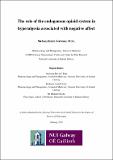| dc.contributor.advisor | Finn, David | |
| dc.contributor.advisor | Kelly, John | |
| dc.contributor.advisor | Roche, Michelle | |
| dc.contributor.author | Ferdousi, Mehnaz | |
| dc.date.accessioned | 2020-02-27T09:43:41Z | |
| dc.date.issued | 2020-02-26 | |
| dc.identifier.uri | http://hdl.handle.net/10379/15807 | |
| dc.description.abstract | Pain and negative affect (anxiety and depression) modulate one another reciprocally. However, the neurobiological mechanisms underlying this interaction are unclear. The endogenous opioid system plays a key role in regulating pain and affect but its role in pain-negative affect interactions, and the influence of genetic background thereon, is poorly understood. The inbred Wistar-Kyoto (WKY) rat, a genetic model of anxiety and depression, displays increased sensitivity to noxious stimuli (hyperalgesia), compared with the control Sprague-Dawley (SD) strain. The overarching hypothesis of this thesis is that alteration in the expression and/or functionality of the opioid system in key components of the descending pain pathway underpin hyperalgesia to inflammatory pain in the WKY rat, compared with SD counterparts.
The results show that WKY rats were hyporesponsive to the mu-opioid receptor (MOP) agonist morphine, administered systemically or into the ventrolateral periaqueductal gray (vlPAG), in the hot plate and formalin tests, compared to SD counterparts. Morphine-induced effects on neuronal activity in regions downstream of the vlPAG were blunted in
WKY rats. WKY rats were also hyporesponsive to kappa-opioid receptor (KOP) modulators, U50488 and DIPPA, in response to acute heat and inflammatory stimuli. In addition, WKY rats displayed exaggerated mechanical allodynia compared to SD
counterparts in the complete Freund’s adjuvant (CFA) model of chronic inflammatory pain. Moreover, CFA induced a modest impairment in recognition memory in SD, but not in WKY, rats. Lastly, chronic SNC80 and DIPPA treatment had no effect on any of the behavioural domains (nociceptive responding/depression/cognition) in the CFA model in SD rats.
In conclusion, these findings suggest that the vlPAG is a key locus for hyporesponsivity to MOP agonism in the WKY rat and a deficit in MOP-induced recruitment of the descending inhibitory pain pathway may underlie hyperalgesia in the WKY rats.
Alteration in the KOP system may also contribute to the WKY behavioural phenotype. Furthermore, the results also provide evidence for genotype-dependent exacerbation of nociceptive responding in the CFA model of chronic inflammatory pain. Taken together, these results extend our understanding on the role of the opioid system in altered nociceptive responding in the WKY rats genetically predisposed to negative affect. | en_IE |
| dc.publisher | NUI Galway | |
| dc.rights | Attribution-NonCommercial-NoDerivs 3.0 Ireland | |
| dc.rights.uri | https://creativecommons.org/licenses/by-nc-nd/3.0/ie/ | |
| dc.subject | opioid | en_IE |
| dc.subject | pain | en_IE |
| dc.subject | hyperalgesia | en_IE |
| dc.subject | negative affect | en_IE |
| dc.subject | anxiety | en_IE |
| dc.subject | depression | en_IE |
| dc.subject | cognition | en_IE |
| dc.subject | periaqueductal gray | en_IE |
| dc.subject | Medicine Nursing and Health Sciences | en_IE |
| dc.subject | Medicine | en_IE |
| dc.subject | Pharmacology and Therapeutics | en_IE |
| dc.title | The role of the endogenous opioid system in hyperalgesia associated with negative affect | en_IE |
| dc.type | Thesis | en |
| dc.contributor.funder | Science Foundation Ireland | en_IE |
| dc.contributor.funder | Alkermes Inc | en_IE |
| dc.local.note | Pain is often comorbid with affective disorders (anxiety and depression) and cognitive dysfunction that negatively affects treatment outcomes, imposing a huge socioeconomic burden. The body of work in this thesis aimed to understand the key role of the opioid system in such an interaction between pain, affect, and cognition. | en_IE |
| dc.description.embargo | 2023-02-26 | |
| dc.local.final | Yes | en_IE |
| dcterms.project | info:eu-repo/grantAgreement/SFI/SFI Strategic Partnership Programme/14/SPP/B3051/IE/The opioid system as the brain's interface between cognition and motivation/ | en_IE |
| nui.item.downloads | 139 | |


